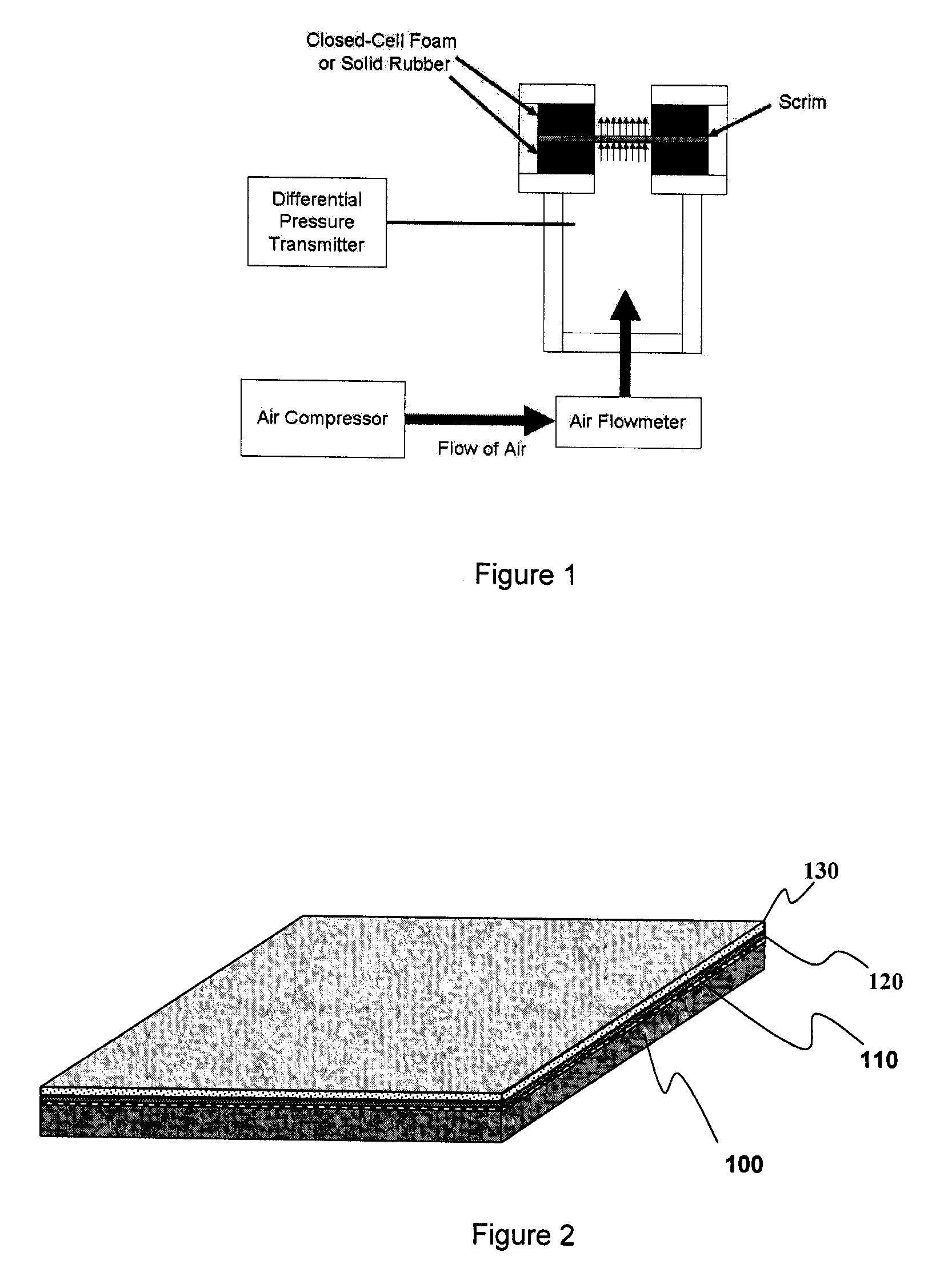Porous nonwoven scrims in acoustical panels
a non-woven scrim and acoustical panel technology, applied in the field of acoustical panels, can solve the problems of insufficient relative movement restriction, poor sag resistance of acoustical panels in humid environments, and insufficient adhesive layer to completely restrict relative movement, etc., to reduce the loss of acoustical absorbency and reduce the loss of specific air flow resistan
- Summary
- Abstract
- Description
- Claims
- Application Information
AI Technical Summary
Benefits of technology
Problems solved by technology
Method used
Image
Examples
example 1
[0046]A base mat comprising mineral wool, newsprint fibers, expanded perlite, starch, and clay was ground to have a relatively smooth surface and coated with a primer. The base mat was then perforated as described above, the perforations having a depth of about 0.4 inches. The perforated base mat had and eNRC of 0.58. A commercially available glue XR-3025 manufactured by HB Fuller of St. Paul, Minn. was sprayed onto said base mats at 4.5 grams / ft2.
[0047]A fiberglass scrim was then laminated onto the base mats. The scrim was purchased from Owens Corning, Toledo, Ohio. The scrim had a specific air flow resistance of 41.4 Rayls, a basis weight of 127.7 g / m2, a thickness of 0.020 inches (0.5 mm), a tensile strength of 45.7 lbf / 2-inch (200 N / 50-mm) in machine direction, and a tensile strength of 42.1 lbf / 2-inch (184 N / 50-mm) in cross machine direction.
[0048]After lamination, the surface was sprayed with a coating. The coating contained about 80% pigments and 20% latex based on total soli...
example 2
[0050]A base mat comprising mineral wool, newsprint fibers, expanded perlite, starch, and clay was ground to have a relatively smooth surface and coated with a primer. The base mat was then perforated as described above, the perforations having a depth of about 0.4 inches. The perforated base mat had an eNRC of 0.46. The commercially available glue XR-3025 mentioned above was sprayed onto said base mats at 4.8 grams / ft2.
[0051]A fiberglass scrim was then laminated onto the base mats. The scrim (sold under the product name Ultra Matt®) was obtained from GAF-Elk Corp. of Ennis, Tex. The scrim had a specific air flow resistance of 15.3 Rayls, basis weight of 76.7 g / m2, a thickness of 0.023 inch (0.58 mm), a tensile strength of 29.8 lbf / 2-inch (130 N / 50-mm) in machine direction, and a tensile strength of 26.7 lbf / 2-inch (117 N / 50-mm) in cross machine direction.
[0052]After lamination, the surface was sprayed with a coating. The coating contained about 80% pigments and 20% latex based on t...
example 3
[0054]A base mat comprising mineral wool, newsprint fibers, expanded perlite, starch, and clay was ground to have a relatively smooth surface and coated with a primer. The base mat was then perforated as described above, the perforations having a depth of about 0.4 inches. The perforated base mat had an eNRC of 0.46.
[0055]The glue XR-3025 was sprayed onto the said base mats at 4.8 grams / ft2. A fiberglass scrim was then laminated onto the base mats. The scrim (sold under the product name Dura-Glass® 7615) was obtained from Johns Manville Corp., Denver, Co. The scrim had a specific air flow resistance of 12.2 Rayls, a basis weight of 60.9 g / m2, a thickness of 0.018 inch (0.46 mm), a tensile strength of 41.4 lbf / 2-inch (181 N / 50-mm) in machine direction, and a tensile strength of 35.2 lbf / 2-inch (154 N / 50-mm) in cross machine direction.
[0056]After lamination, the surface was sprayed with a coating containing about 80% pigments and 20% latex based on total solids content. It had a solid...
PUM
| Property | Measurement | Unit |
|---|---|---|
| air flow resistance | aaaaa | aaaaa |
| thickness | aaaaa | aaaaa |
| thickness | aaaaa | aaaaa |
Abstract
Description
Claims
Application Information
 Login to View More
Login to View More - R&D
- Intellectual Property
- Life Sciences
- Materials
- Tech Scout
- Unparalleled Data Quality
- Higher Quality Content
- 60% Fewer Hallucinations
Browse by: Latest US Patents, China's latest patents, Technical Efficacy Thesaurus, Application Domain, Technology Topic, Popular Technical Reports.
© 2025 PatSnap. All rights reserved.Legal|Privacy policy|Modern Slavery Act Transparency Statement|Sitemap|About US| Contact US: help@patsnap.com



